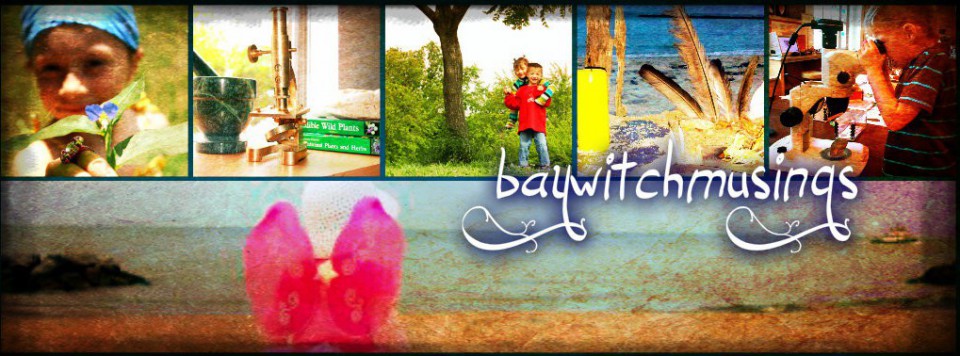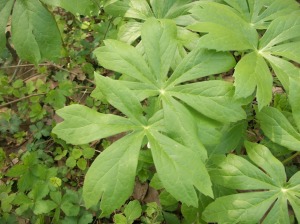I thought that each month I’d try to feature local foragables (yay, I invented a word!), wildflowers, animals, ect as I come across them in my rambles. I had meant to start this last month, but I was a bit preoccupied at the time, and never got the post completed…but, better late than never!
Last month, on a trek to the zoo with the kids and my brother, I walked right past a May apple patch in Forest Park. Unfortunately, I only had my pocket camera with the imprecise zoom and was unable to get a good shot of the flower–every time I *thought* I had it focused, the darn thing refocused on the leaves in the background instead. And, as if May apples weren’t something to be excited about on their own, my grandfather brought home the motherload of morels from his secret mushroom hunting spot in southern Illinois, some of which my grandma was kind enough to make for me!
mmmmmmmmm, morrells…
Anyhoo, I thought I’d include a bit about each plant (or organism)–not an entire write up like I do with some of the other herbs, but some basic info, along with whatever notable information I come across.
*****
Mayapple
Podophyllum peltatum
Barberry family (Berberidaceae)
The May apple is a pretty interesting plant. It has a gorgeously unique foliage (awesome pics at this site) and (as a bit of a misnomer) flowers in April/May, producing a fruit in July/August. The entire plant, with exception of the properly ripened fruit (specifically, the inner flesh of the fruit) is extremely toxic. I have never tried the fruit–never caught at the right time, which is said to be when the fruit turns yellow like a lemon and is soft to the touch. And, from what I have read, many people that would ordinarily try the May apple have trouble finding fully ripe fruit, which are a favorite of wildlife (another common name for the May apple is the “raccoon berry”). Description of the taste varies from “tasteless” to “slightly lemon like” to “melon-ish”.
The May apple is native to the eastern North America, and is an easy to grow addition (from the rhizome) for shady areas in native landscaping. It can be grown from seed or from rhizomes, but is more commonly found, carpeting the forest floor in Eastern woodlands. I have seen recommendations that persons wanting to harvest the fruit, either in a wild patch or a garden plot, should put screening around the area in question to keep out small animals that enjoy the fruits.
Something I find interesting is that although mayapple spreads easily by underground rhizomes once a single plant becomes well-rooted, mayapple often needs a bit of help getting started from seed.
Box turtles are an important catalyst for mayapple because these unique reptiles are one of the most important depositors of the plants’ heavily coated seeds. Without passing through the digestive tract of animals, mayapple seeds have very low germination rates, and box turtles appear to have one of the better suited “mechanics” for making the seeds more ready to grow after the land-loving turtles enjoy the low-hanging mayapple fruit.
The Great Outdoors: Mayapple a unique plant; By Geordan T. Howell
Magically, the plant is considered to have properties similar to that of mandrake but they are not related (mandrake and American mandrake are alternative common names for the May apple. I have seen some claim to use May apple root for protection, fertility and to draw wealth…though it seems to me that there are probably better (and less toxic) plants with these correspondences.* Additionally, the active chemicals in the plants have been under investigation for potential cancer treatments. Historically the plant was used by Native Americans as both a food source and medicinally**.
*There have been some anecdotal references that would indicate that powdering any part of this plant for use is a bad idea and can cause extreme skin and eye irritation and damage if handled improperly.
**Ethnobotanical research suggests that various tribes used all parts of the plant medicinally, but most notably the root stock, and usually as an emetic, cathartic or laxative, after specific preparation.
*****
Morel
Morchella esculenta, Morchella deliciosa
The morel is an extremely tasty ascocarp–a member of the family Ascomycota. As with all mushrooms, one should be certain of their skill, or the skill of the individual foraging before consumption. There are a number of fungi given the moniker false morels for their similarity.
Morchellas are normally found in forest areas. Their mycelium connect with tree roots; these relationships can be mycorrhizal or saprobic. Morchella typically form relationships with hardwood and conifer trees. They can often be found around ash, dying elms, or in apple orchards. Morchella deliciosa are often referred to as “tulip morels” or “hickory morels” because they are commonly found under these trees. The classis yellow morel is quite common in North America, but is not restricted to just this continent.
Because Morchella fungi are so highly coveted for culinary uses, many researchers are studying the biological diversity of these organisms in order to ensure that they do not become threatened. Dalglelish and Jacobsen (2005) noted that the potential for inbreeding within Morchella esculenta is high, but that this species does not interbreed at high rates. The cultivation of Morchella species has proved difficult. While there are some detectable patterns in habitats and growth conditions, these are not consistent enough to be used for general cultivation.




There was a company in Michigan (Magic Mountain) which had patented a method for growing morels, but it seems that they had a proprietary subspecies because nobody has been able to duplicate their methods successfully. They are no longer in business.
If you are unsure if the mushroom you have found is a morel or not, the easiest way to tell is to cut it in half, top to bottom. If the stem attaches to the top center of the cap, it’s not a morel.
With morels, the stem attaches to the lower edges of the cap – cut in half, the mushroom should be hollow and look like a cookie cutter for Christmas tree shaped cookies.
Black morels tend to be more Christmas tree shaped, white morels tend to be more globular (and frequently larger – I’ve seen them up to ten inches tall) – but in both cases the stem is more like a continuation of the cap, and DEFINITELY not attached to the center of the cap.
As always, you are a font of wisdom! Since I don’t hunt ’em, I feel awkward giving that sort of advice!
I loved this piece, my dear. There is a little may apple “grove” across our street in a neighbor’s back yard wooded area. He has given me permission to take all I want to replant, because he intends to kill them all. I cannot dissuade him for the life of me.
At first I thought you were going to offer info about finding may apples AND morels growing together. We used to have morels in the lawn of our 1841 Federal farmhouse. The spores eveidently blew in from a large stand in the old apple orchard on the back slope of the farmlands. The orchard is gone now (never way mine), and cattle graze the area. My late husband decided to put weed-killer on the lawn and lo, the morels disappeared while the weeds returned too soon to have bothered. Why do guys so like to kill things off??? I am off now to dig rhizomes of may apples, and check out the ripeness of the fruit before I try a May Apple Chiffon Pie by Euell Gibbons. (have had that recipe for eons.)
I see typos, but cannot get into the message for corrections. Sorry about spore and never was mine. What else do YOU see that is wrong? Mae
lol, don’t worry about it…I leave typos all the time! You are not alone. I have an auto-spell checker in my browser, and it still doesn’t catch when I do stuff that is *really* another word!
I have to say that I am jealous of getting to live in a big old farmhouse like that–the hubby and I do Civil War reenactments and it is my dream to have a historic 19th century home to put my Elias Howe tredal sewing machine in!
And I LOVE Euell Gibbons. I found Stalking the Wild Asparagus as a teen, browsing in the library, and have been an on again/off again forager ever since. I will have to look up that recipe.
Also, thank you! You completely reminded me that I forgot to do what we found in June while out and about!!